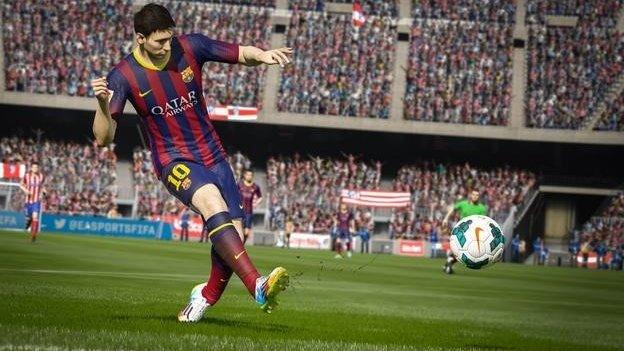Alien attacks and Fifa 15 chants: The art of video game noise
- Published
Marc Cieslak reviews the new video game Alien: Isolation
Sound design is often the unsung hero of video games. But when developers get it right, primal instincts are triggered, helping immerse players in the action. Below, the brains behind the soundscapes of five of this year's biggest releases discuss their art in exclusive interviews with the BBC:
Skulking through the corridors of Alien: Isolation's derelict space station you strain to pick out the footsteps of the 9ft-creature hunting you from the creaks and ominous throbs of the surrounding walls and air ducts.
In the distance you think you make out a reptilian "croak".
A glimpse of the motion tracker confirms you're not alone, prompting you to hide inside a cabinet - but the door's slam is too loud and your own intake of breath threatens to give you away as the now unmistakable thud of beast approaches.
Playing the spin-off of Ridley Scott's 1979 movie is a fraught experience.
"We went for a sense of realism, but at the same time all the sounds had to have an emotional context to them," says Byron Bullock, the title's sound designer.
"We want the player to feel scared. Things like the motion tracker, for example, as soon as you hear that beep it puts you on edge.
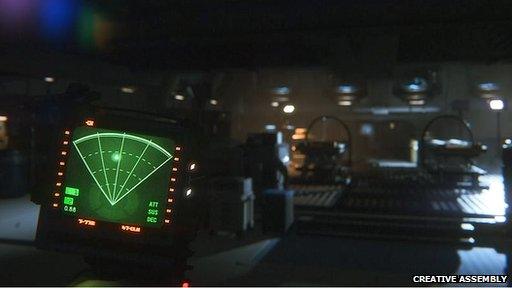
Alien: Isolation's motion tracker warns you of the creature's approach before you see it
"It's almost like a heartbeat to it - it gets faster and faster and higher in pitch. That can make you feel anxious."
Deep breath
Another sci-fi titan, George Lucas once said that, external "sound is half" the movie-going experience, adding that it's "where you get the most bang for your buck".
But while film-makers have the luxury of knowing what's going to happen next, sound in games is a more complicated affair.
"One of the most important things in horror is creating suspense and tension. That's easier in a film because it's a linear medium," Mr Bullock explains.
"A sound designer will know what's happening in the next 10 seconds. They can pre-empt situations with sound-effects, music and by changing the mix.
"We wanted to do a similar thing in Alien: Isolation but because the gameplay is so dynamic - the Alien is unpredictable - it became an exercise in creating systems.
Alien: Isolation uses sound to scare
"So, we have a value called Stealth, which tells us at any given moment how stealthy the player is being - how much noise they are making, how close they are to an enemy, the enemy's awareness of the player.
"We use that to both change the music and the mix. We will lower the atmosphere and raise up the Alien's sounds and Ripley's breathing rate.
"You don't want to be making any noise at that point, so we'll start to raise up your sounds a little bit just to put you on edge."
Football chants
By its nature, Fifa 15 seeks a very different audio aesthetic.
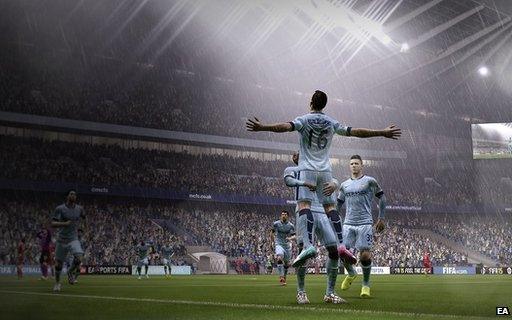
Fifa 15 has more crowd chants for the major teams than previous versions of the game
Authenticity is the watchword for the world's best-selling football simulator.
To achieve it, the title's creators teamed up with TV sports broadcasters across the globe, which provided recordings taken from several games.
Each delivered up to 32 separate but simultaneously recorded tracks created by microphones dotted around the stadium involved.
LISTEN: Hear some of the Liverpool FC chants recorded for Fifa 15
As well as delivering "realistic" effects for the rattle of goal frames and spectators' "oohs" and "ahs", this also allowed the developers to provide "thousands" of real chants and songs.
"With our 10,000 or whatever years of evolution, we can really hear the emotional content of what's being said or sung," says Jeffrey MacPherson, justifying the time-consuming and expensive effort.
"There's no substituting the real deal. When you're at Anfield and hearing, 'You'll never walk alone,' it's truly hair-raising. We'd prefer to go to great lengths to acquire that experience rather than trying to simulate it."
However, making use of this haul posed challenges.
Richard Taylor asks EA Sports' David Rutter what is new in its next Fifa game.
Chants featuring swear words had to be identified and ditched - a particular problem at South American games, Mr MacPherson remarks.
And a pro-independence chant recorded at Barcelona's Camp Nou stadium caused controversy in Spain after a "perfect storm" of factors let it slip through to the demo version of the game. It doesn't appear in the final release.
"It generated a whole lot of press, that's for sure," Mr MacPherson recalls.
"In our quest to be authentic we have to be even more vigilant, and what we end up doing is creating a censored version of reality.
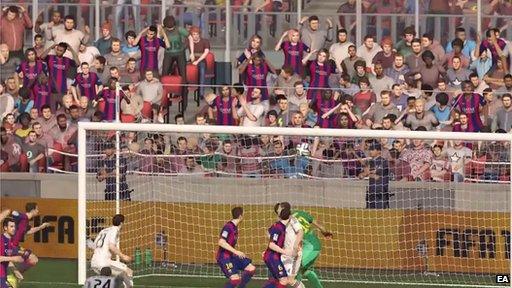
EA removed FC Barcelona fans' Independencia chant from the final version of Fifa 15
"When you play a match you're not going to hear the same breadth of content that you would hear at the grounds on a Saturday afternoon. You'll get 35% to 40% of what you might hear.
"That's just the nature of having an E for everyone-rated game."
Destiny's demands
Bungie took a very different approach with its recently released sci-fi shooter Destiny.
"Almost everything that you hear in Destiny was created from scratch, in-house," states audio director C Paul Johnson.

Destiny is Bungie's first game since the Halo series, which had distinctive sounds of its own
"Part of it's professional pride, and [part] to give players something unique to enjoy."
Exotic sounds required searching out unusual techniques.
The sound of one enemy class - the Vex - was inspired by a performance artist who had uploaded a video of himself to YouTube, copied it, uploaded it again, and repeated this about 1,000 times.
"He came up with this really crazy sound that sounded mechanical and robotic but had emotiveness to it," Mr Johnson recalls.
"So we wrote a little program and used the sound of big cats - cheetahs or something - and ran it through a process like that... hundreds and hundreds of times."
Vex effects
To deliver the perfect sound for dirt footprints Mr Johnson says he and another team member travelled "all over" the state of Washington, until they finally got what they wanted at the top of a mountain range.
"We probably burnt thousands and thousands of dollars of people's time just to get those footstep recordings to sound good," he says.
"You obsess over every single asset [but] I think the net effect of that is awesome-sounding stuff."
And then there's the game's multitude of weapons.
A three-day trip to Las Vegas to shoot "every gun we could think of" provided the raw material, which was later made to sound sci-fi back at base.
But the critical trick, Mr Johnson adds, was to ensure that each shot fired sounded different.
Sound effects for gunfire
"Every sound has at least three versions," he explains.
"You'll cycle between those versions so you never hear the same sound file twice in a row. You won't get that broken record effect.
"We use both randomised pitch shifting and actual different samples between each firing.
"And it's not just weapons, it's everything - the footsteps, the background ambiences and the character screams - everything except the mission dialogue basically".
Wind and cloth
Ubisoft has its fair share of weapons in forthcoming open-world adventures Far Cry 4 and Assassin's Creed Unity.
But the audio directors of both games are currently obsessed about more commonplace features.
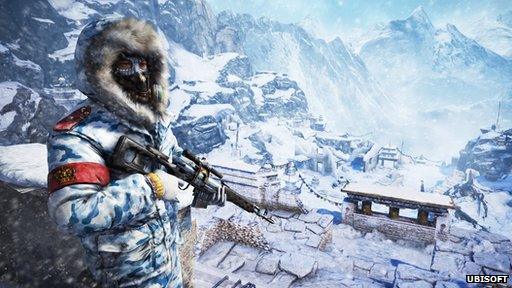
Far Cry 4 involves the protagonist aiding a rebellion in a fictitious Himalayan kingdom
In Far Cry 4, set in the Himalayas, it's the wind that is preoccupying Tony Gronick.
"We knew when we went up higher in the regions - in the snow areas - that we would have difficult with ambiences, and the wind would have to carry most of it," he explains.
"So, what we did was we hired a Japanese flute player and we got her to blow single notes into a microphone. And then what I did was took those and slowed them down and added them to wind gusts."
The effect, he adds, is that the tonal gusts create a sense of desolation and fear.
"Sometimes that flute will just echo and make you feel both cold and frightened at the same time."
In the case of French-revolution set Assassin's Creed Unity, Tchae Measroch highlights that one benefit of restricting the title to "new-gen" consoles - the Xbox One and PlayStation 4 - and PCs is that he has more memory to devote to the sounds of the protagonist's movements.
LISTEN: Compare some of the different types of footsteps in Assassin's Creed Unity
"If you push the character forward to do one footstep there are [up to] 30 sounds playing at the same time," he explains.
"The footsteps, the cloth, the jingle of the sword, his cape, the friction of his coat. And all of these are very specific to every little bit of animation and the surface [he's moving on].
"It's hundreds, I'd say thousands of files in the data there."
Out of time
With many titles providing 15 or more hours of core gameplay - and several times that amount once you add side-missions and add-on content - the demands on video game sound design teams can be immense.
From recording the sound of dry ice on metal to create the groans of Alien: Isolation's dying space station to twisting door knobs to simulate the sound of Assassin's Creed's 18th Century weapons, the teams responsible must be inventive.
But they are also required to be resilient - especially as deadlines loom.
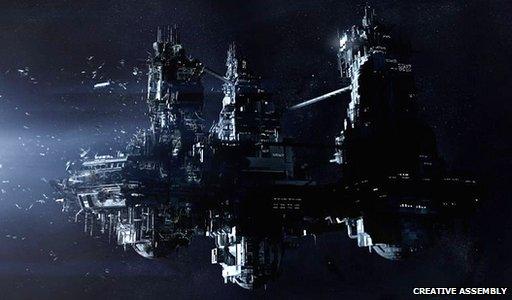
The sound of the Sevastopol space station coming under strain was created using dry ice
So if sometimes it's a glitch rather than a subtle atmospheric effect that most stands out, it's worth remembering the pressure they are put under.
"Unlike film or television where you can start at point A and end at point B, in games it's constantly changing," notes Mr Gronick.
"The story is changing, the location is changing, the weapons are changing.
"What happens is that everyone is rushing to get their work in at the end, and sometimes you end up after two years of work just trying to get the systems that were working a year ago fixed.
"Sometimes you just lose that polish phase. It can be frustrating, but it's also a challenge."
- Published1 October 2014
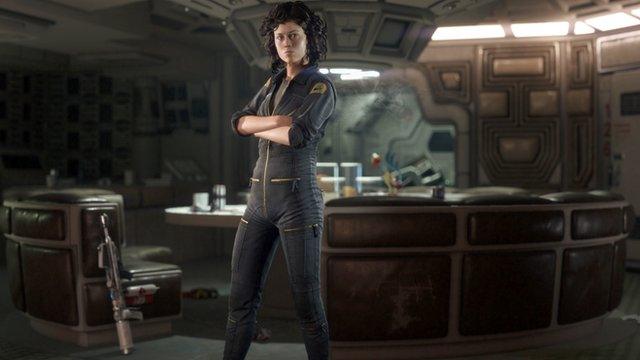
- Published9 September 2014
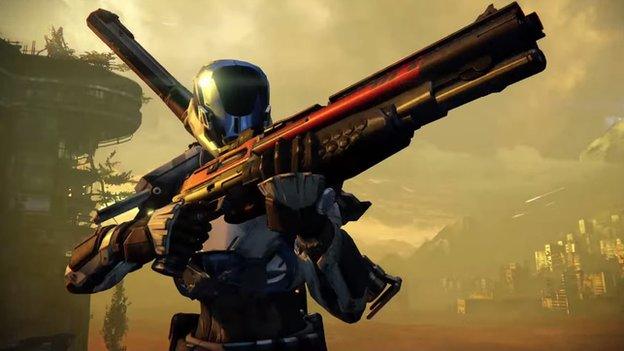
- Published12 June 2014
